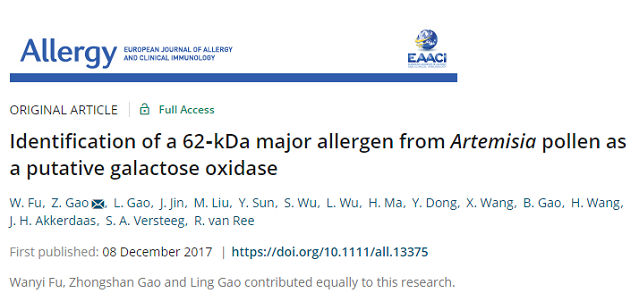On 8 May, 2018, a research article entitled “Identification of a 62 kDa major allergen from Artemisia pollen as a putative galactose oxidase” was published on Allergy, 2018,73:1041-1052 (https://onlinelibrary.wiley.com/doi/epdf/10.1111/all.13375). PhD student FU Wanyi at College of Agriculture and Biotechnology, Zhejiang University, is the first author of the article. Prof. GAO Zhongshan is the corresponding author.
Artemisia pollens have been recognized as one of the major causes for late summer and autumn allergic respiratory disease in the northern hemisphere. In China, the frequency of Artemisia pollen sensitization among pollinosis patients isaround 60% in the North due to very high pollen exposure from several Artemisia species, including sweet wormwood (A. annua), the source of artemisinin.
Artemisia vulgaris, mugwort, is one of the best studied weed species in Europe, and six of seven of its reported allergens have been listed in the IUIS allergen nomenclature database, but surprisingly the first identified “Art v 60 kDa” (formerly known as Art v I, initially reported over two decades ago)had not been given an official name due to lacking molecular information.
By immunological and biological approaches with the aid of state-of-the-art transcriptomics and proteomics tools, the major Artemisia pollen allergen “Art v 60 kDa” was identified as a 62 kDa galactose oxidase. About 90% of Artemisia allergic patients had an IgE response to this allergen.This new allergen has now been designated Art an 7 by WHO/IUIS, Allergen Nomenclature Sub-committee. The outcome of this study may promote component resolved diagnosis and associated food allergic reactions, and further research into the role of galactose oxidases in weed pollen allergies.
